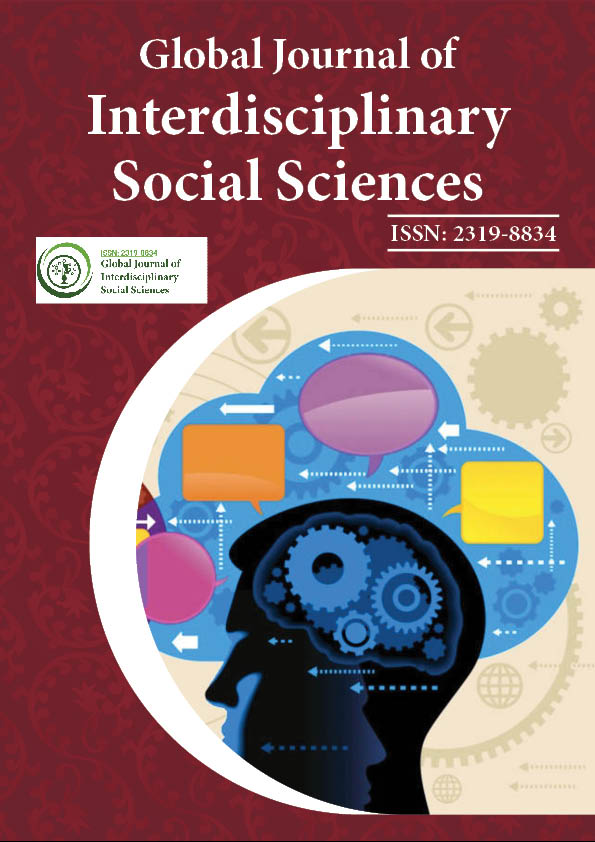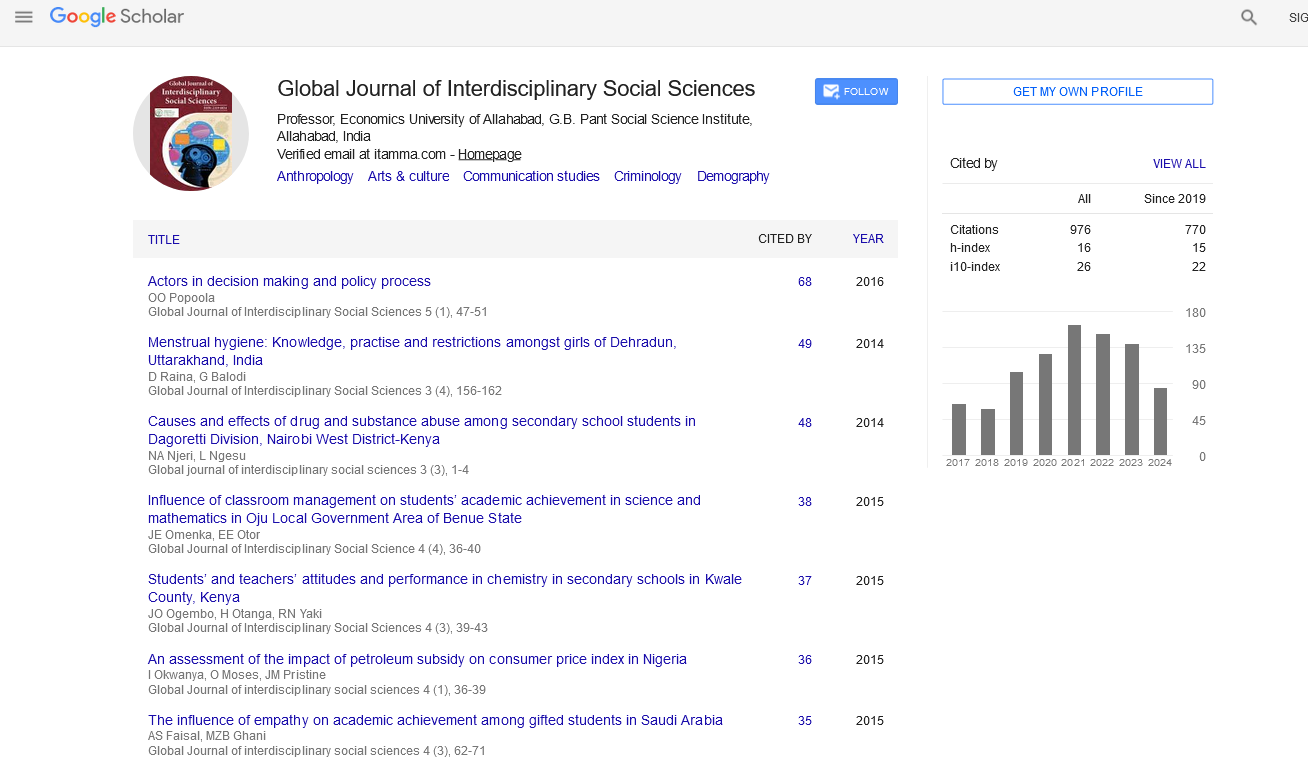Indexed In
- JournalTOCs
- Google Scholar
Useful Links
Share This Page
Journal Flyer

Open Access Journals
- Agri and Aquaculture
- Biochemistry
- Bioinformatics & Systems Biology
- Business & Management
- Chemistry
- Clinical Sciences
- Engineering
- Food & Nutrition
- General Science
- Genetics & Molecular Biology
- Immunology & Microbiology
- Medical Sciences
- Neuroscience & Psychology
- Nursing & Health Care
- Pharmaceutical Sciences
Perspective - (2024) Volume 13, Issue 1
Global Perspectives on Biodiversity Conservation: Challenges and Opportunities
Sofia Martinez*Received: 28-Feb-2024, Manuscript No. GJISS-24-27875; Editor assigned: 01-Mar-2024, Pre QC No. GJISS-24-27875 (PQ); Reviewed: 15-Mar-2024, QC No. GJISS-24-27875; Revised: 22-Mar-2024, Manuscript No. GJISS-24-27875 (R); Published: 29-Mar-2024, DOI: 10.35248/2319-8834.24.13.078
Description
The political economy of biodiversity conservation is an interdisciplinary field that examines the complex relationships between economic systems, political frameworks, and the ecological consequences of human activity. In summary, it investigates how political policies, economic incentives, and social practices shape the conservation of biological diversity. This essay explores into the historical context of biodiversity conservation, highlights influential persons that have significantly influenced the field, and evaluates both the positive and negative aspects associated with these approaches.
Historically, the notion of biodiversity conservation can be traced back to the early environmental movements of the 20th century, which arose in response to the accelerated industrialization and urbanization that characterized this period. The post-World War II era saw a burgeoning awareness of environmental issues, prompted by the publication of influential works. This seminal work inspired public opinion against the uncontrolled use of pesticides and highlighted the interconnectedness of human health and the health of ecosystems. Importantly, it set the stage for a broader discourse on environmental preservation and the necessity for policy reforms aimed at conserving biodiversity.
As biodiversity conservation gained traction, numerous influential persons emerged as significant contributors in this domain. The establishment of international frameworks, such as the Convention on Biological Diversity (CBD) in 1992, marked a significant milestone in formalizing the political commitment toward biodiversity conservation. Prominent persons played a critical role in promoting the importance of global cooperation in the conservation efforts. Under his leadership, the CBD emphasized sustainable development and biodiversity’s intrinsic value, effectively combining ecological considerations into the political economy.
The significant contributor of Kenyan environmental and political activists known for their efforts in advocating for sustainable environmental practices. Through their establishment of the Green Belt Movement, Maathai linked biodiversity conservation with social justice, empowering local communities to engage in tree planting and land reclamation. This initiative not only enhanced local ecosystems but also promoted gender equality and economic empowerment, demonstrating a successful model in which conservation and socio-economic development can coincide.
Despite the positive strides made in the political economy of biodiversity conservation, several challenges and criticisms persist. A predominant issue is the tension between economic development and conservation efforts. Countries rich in biodiversity often struggle with the lure of exploiting natural resources for economic gain, leading to habitat destruction and biodiversity loss. This dilemma is pronounced in developing nations, where the immediate economic needs of communities can overshadow long-term environmental considerations. The concept of “greenwashing” emerges in this context, where businesses and governments exaggerate their commitment to sustainability while engaging in practices detrimental to biodiversity.
Moreover, the implementation of biodiversity conservation measures often reflects power dynamics and inequalities. Indigenous communities frequently find themselves marginalized in conservation dialogues, as external conservation policies may overlook their traditional ecological knowledge and rights to land. The establishment of protected areas, although well-intentioned, can result in the displacement of local populations and loss of livelihoods. This critique highlights the need for inclusive policies that incorporate the voices of indigenous peoples and local communities, ensuring that conservation strategies are equitably designed and adopted.
Nevertheless, positive frameworks have emerged that aim to reconcile these conflicts. The concept of Payment for Ecosystem Services (PES) is one such initiative where economic incentives are provided to landowners or communities to conserve biodiversity. This mechanism recognizes the economic value of ecosystem services and promotes conservation through financial compensation, aligning economic interests with conservation objectives. Successful examples include programs in Costa Rica, where local communities are rewarded for reforestation efforts, thereby promoting both biodiversity conservation and local economies.
Furthermore, the role of international cooperation remains most important in mitigating negative aspects related to biodiversity conservation. Treaties and agreements, such as the Paris Agreement and the CBD, emphasize the need for unified international responses to biodiversity crises. Collaborative research initiatives and cross-border biodiversity programs aim to harmonize conservation efforts, illustrating the importance of shared responsibility in addressing issues that transcend national boundaries.
In conclusion, the political economy of biodiversity conservation embodies a complex exchange among economic, political, and ecological dimensions. By examining this complex environment, the article has highlighted the historical context of biodiversity conservation, emphasizing influential persons and their contributions. While significant progress has been made in promoting conservation, challenges remain, particularly concerning the balance between economic growth and environmental sustainability. Ultimately, a sustainable future relies on collaborative efforts that integrate diverse voices and perspectives, ensuring both the preservation of biodiversity and the well-being of communities worldwide.
Citation: Martinez S (2024). Global Perspectives on Biodiversity Conservation: Challenges and Opportunities. Global J Interdiscipl Soc Sci. 13:078.
Copyright: © 2024 Martinez S. This is an open access article distributed under the terms of the Creative Commons Attribution License, which permits unrestricted use, distribution, and reproduction in any medium, provided the original author and source are credited.

